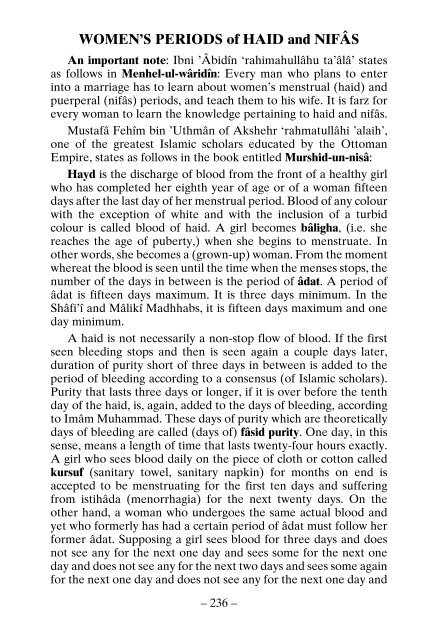O Son !
THE BOOK ‘O SON’ Al-hamdu lillâhi Rabbil ’âlamîn. Wa-s-salâtu wa-s-salâmu ’alâ Rasûlinâ Muhammadin wa Âlihi wa Sahbihi ajma’în. 1– O son! Collecting from books written by the scholars of the Hanafî Madhhab three hundred and sixty hadîth-i-sherîfs and forty-four khabars and also the seven essentials and the five rukns and the seven wâjibs and the fourteen sunnats and the twenty-five mustahabs and the fourteen mufsids of namâz, I have explained them for you. Adapt your acts and deeds to these teachings so that you attain fayz and nejât (salvation)! 2– Also for your information, I have collected a thousand and ninety âdâb (adabs) for you and for other young Muslims like you. If you adapt your actions and acts of worship to these teachings, they will be sufficient for you. If you laze, disobey Allâhu ta’âlâ and cease from these practices and manners, you will be afflicted with slavery and disgrace in the world and subjected to torment in the world to come. If you live up to them and advise your Muslim brothers to do the same, it will be useful for you. They will say blessings over you. And Haqq ta’âlâ will accept their invocations. For, a slave will be pardoned on account of another slave’s invocations for them.
THE BOOK ‘O SON’
Al-hamdu lillâhi Rabbil ’âlamîn. Wa-s-salâtu wa-s-salâmu ’alâ
Rasûlinâ Muhammadin wa Âlihi wa Sahbihi ajma’în.
1– O son! Collecting from books written by the scholars of the
Hanafî Madhhab three hundred and sixty hadîth-i-sherîfs and
forty-four khabars and also the seven essentials and the five rukns
and the seven wâjibs and the fourteen sunnats and the twenty-five
mustahabs and the fourteen mufsids of namâz, I have explained
them for you. Adapt your acts and deeds to these teachings so that
you attain fayz and nejât (salvation)!
2– Also for your information, I have collected a thousand and
ninety âdâb (adabs) for you and for other young Muslims like you.
If you adapt your actions and acts of worship to these teachings,
they will be sufficient for you. If you laze, disobey Allâhu ta’âlâ
and cease from these practices and manners, you will be afflicted
with slavery and disgrace in the world and subjected to torment in
the world to come.
If you live up to them and advise your Muslim brothers to do
the same, it will be useful for you. They will say blessings over you.
And Haqq ta’âlâ will accept their invocations. For, a slave will be
pardoned on account of another slave’s invocations for them.
You also want an ePaper? Increase the reach of your titles
YUMPU automatically turns print PDFs into web optimized ePapers that Google loves.
WOMEN’S PERIODS of HAID and NIFÂS<br />
An important note: Ibni ’Âbidîn ‘rahimahullâhu ta’âlâ’ states<br />
as follows in Menhel-ul-wâridîn: Every man who plans to enter<br />
into a marriage has to learn about women’s menstrual (haid) and<br />
puerperal (nifâs) periods, and teach them to his wife. It is farz for<br />
every woman to learn the knowledge pertaining to haid and nifâs.<br />
Mustafâ Fehîm bin ’Uthmân of Akshehr ‘rahmatullâhi ’alaih’,<br />
one of the greatest Islamic scholars educated by the Ottoman<br />
Empire, states as follows in the book entitled Murshid-un-nisâ:<br />
Hayd is the discharge of blood from the front of a healthy girl<br />
who has completed her eighth year of age or of a woman fifteen<br />
days after the last day of her menstrual period. Blood of any colour<br />
with the exception of white and with the inclusion of a turbid<br />
colour is called blood of haid. A girl becomes bâligha, (i.e. she<br />
reaches the age of puberty,) when she begins to menstruate. In<br />
other words, she becomes a (grown-up) woman. From the moment<br />
whereat the blood is seen until the time when the menses stops, the<br />
number of the days in between is the period of âdat. A period of<br />
âdat is fifteen days maximum. It is three days minimum. In the<br />
Shâfi’î and Mâlikî Madhhabs, it is fifteen days maximum and one<br />
day minimum.<br />
A haid is not necessarily a non-stop flow of blood. If the first<br />
seen bleeding stops and then is seen again a couple days later,<br />
duration of purity short of three days in between is added to the<br />
period of bleeding according to a consensus (of Islamic scholars).<br />
Purity that lasts three days or longer, if it is over before the tenth<br />
day of the haid, is, again, added to the days of bleeding, according<br />
to Imâm Muhammad. These days of purity which are theoretically<br />
days of bleeding are called (days of) fâsid purity. One day, in this<br />
sense, means a length of time that lasts twenty-four hours exactly.<br />
A girl who sees blood daily on the piece of cloth or cotton called<br />
kursuf (sanitary towel, sanitary napkin) for months on end is<br />
accepted to be menstruating for the first ten days and suffering<br />
from istihâda (menorrhagia) for the next twenty days. On the<br />
other hand, a woman who undergoes the same actual blood and<br />
yet who formerly has had a certain period of âdat must follow her<br />
former âdat. Supposing a girl sees blood for three days and does<br />
not see any for the next one day and sees some for the next one<br />
day and does not see any for the next two days and sees some again<br />
for the next one day and does not see any for the next one day and<br />
– 236 –

















